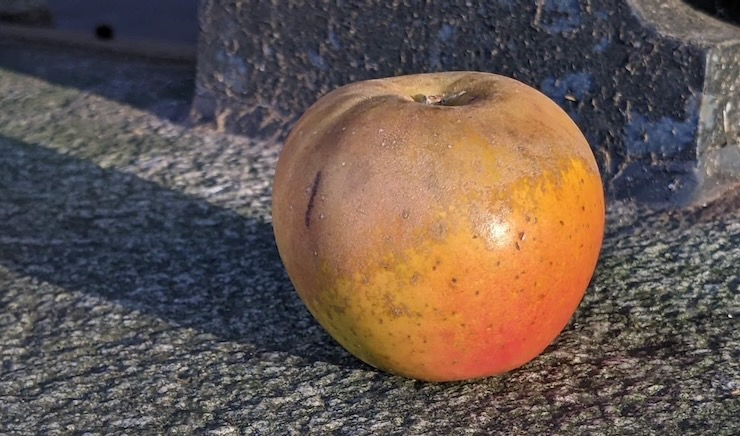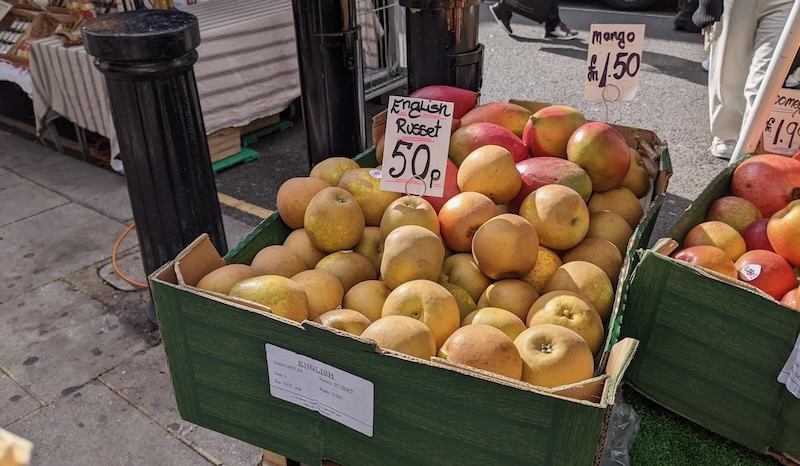
|
I'm not certain today's apple is the true English Russet and would welcome any suggestions about that from my readers.
I do love a mystery.
The above combination of rosy blush, light brown russet, and green-tinged yellow (in the unblushed peel) makes this sample a complex visual treat.
More description
This apple is oblate and broad, with a thick stem peering from a shallow stem wells, and an open calyx.
It is promisingly firm.
I hope that's not too tedious, but even small details might aid identification. The important part is
The eating
 To be honest I am struggling to identify the lead flavor, though it is
possible to pick out cane sugar and secondary notes of
flowers, pear, and vanilla,
and perhaps generic berries.
To be honest I am struggling to identify the lead flavor, though it is
possible to pick out cane sugar and secondary notes of
flowers, pear, and vanilla,
and perhaps generic berries.
Possibly what I am struggling to identify is the harmonious synthesis of these elements.
I quite understand the industry's objection to a mass-market russet in America, even as I am not sympathetic to it. Everybody here "knows" that apples are supposed to be red (or maybe green, but let's not push it) and at any rate never brown.
But based on flavor signature I would expect this apple to have a real following out here. It is sweet, easy to eat, and interesting without being in any way offensive.
The plot thickens

|
| The apples at Portobello Market. Note the PLU stickers on some apples. The sign, and the label on the side of the box, identify these as English Russet. |
I assumed it was an Egremont, and chose this sample specifically to photograph the blush, which I took to be a possible characteristic of the breed. Most of the other apples did not have any blush at all.
(Incidentally, that is why my initial photo shows so much blush and so little russet. I staged the shot that way.)
Fortunately, I also had several true Egremont Russet apples of conventional appearance. Tasting the blushed version suggested that I had an entirely different variety.
Karim Habibi, the owner of a fruit tree nursery in Kent, told me he'd never seen a blushed version like mine. "That isn't Egremont," he said, when I showed him a photo.
Blushing to admit
So what about English Russet? Is that even a cultivated variety, or just a generic class, a russet from England? As in "we''ll put whatever russets we have into the box and call them that."
Pomiferous has a description of English Russet that fits the bill with regard to blush: "The base colour is yellow blushed orange on the sun-exposed face."
That variety, Pomiferous says, was developed by Frederick William Wastie, a Victorian-era apple breeder.

|
| Same apple, different angle. |
Pomiferous gives two conflicting accounts of English Russet's pedigree, but both versions have the Sturmer Pippin as seed parent.
Open to debate
This is far from a common variety. Neither Orange Pippin nor Keepers Nursery list English Russet.
The National Fruit Collection in the UK has it as a variant name for Roxbury Russet. This is not that.
How could such an obscure variety end up for sale, properly labeled, with a bunch of Egremont Russets at a street market in London?
So perhaps it is something else entirely.
Please share your thoughts in comments.
Just to add to the data, our Golden Russets (whatever they might be!) blush occasionally. They also sunburn, but the blush is different.
ReplyDeleteThanks, Tim! I didn't mean to suggest that russet apples do not blush.
DeleteFor that matter, I've seen photos of Egremonts with faint blushes. But not like this one!
It looks quite a bit like our Golden Russet (not american golden russet aka bullocks pippin). It is also sometimes called English Russet as I recall. I also have used the word harmonious many times to describe the eating experience. The flavors, acidity, sugar and texture all play together really well. Who knows, maybe some relative, or even Golden Russet. Maybe they are actually the same. I imagine it won't be too long until genetic testing clears that all up.
ReplyDeleteI thought of this post when, in my local greengrocers in south Manchester, UK this morning, I saw a box of identical looking apples - varying from fully russeted to the partial russet apples with a blush as you describe. In fact I chose some of the blushed examples especially as a result of your review.
ReplyDeleteFor me the mystery of identification remains, because these apples were also labelled as English Russets - but with the English in smaller writing in the top left corner of the label, where on the adjacent boxes was French Braeburn and Dutch Comice Pears. So these apples were being sold as Russets-from-England not English Russet specifically. I've noticed the same in other greengrocers and the supermarket M&S, where bags of apples were sold as simply "Russets", with no specific variety identified anywhere on the bag. Of course that doesn't mean that these apples aren't also English Russet...
I think what you have there could be a 'Claygate Pearmain'. It looks and sounds a lot like the CPs that have been available for the past few weeks from our local Deli, Village Greens in Prestwich, and have been eating very nicely until the last week or so, when the last batch I bought turned out to be a little too floury for my preference.
ReplyDeleteFlavour-wise, they sound about right, and they do have that blend of pronounced russeting, with a strong blush on a greenish yellow, ripening to yellow-gold ground.
I went looking for Claygate Pearmain reference pics online and a lot of them look under-ripe to me, but there are some likely-looking shots at FruitID: https://www.fruitid.com/#view/517